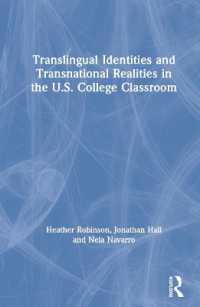Full Description
Nick C. Ellis, Ute Romer, and Matthew Brook O'Donnell present a view of language as a complex adaptive system that is learned through usage. In a series of research studies, they analyze Verb-Argument Constructions (VACs) in first and second language learning, processing, and use. Drawing on diverse epistemological and methodological perspectives, they show how language emerges out of multiple experiences of meaning-making. In the development of both mother tongue and additional languages, each usage experience affects construction knowledge following general principles of learning relating to frequency, contingency, and semantic prototypicality. The implications of this work will be of value to students and scholars from a wide range of disciplinary interests in language and learning. "This is an impressive volume that will inspire researchers for generations to come. Focusing on the construction and acquisition of language, it combines a comprehensive synthesis of theory with a detailed account of extensive empirical work." Susan Hunston, University of Birmingham "This book is a phenomenal synthesis of a formidable research program.In a feast of corpus, psycholinguistic, acquisitional, and simulation evidence, the authors bold theoretical insights advance knowledge about human language to unprecedented levels." Lourdes Ortega, Georgetown University "The authors present a superb synthesis of approaches to verb-argument constructions and convincingly demonstrate the close links between lexical patterning and constructional meaning. An absolute must-read for anyone interested in usage-based approaches to language learning." Ewa Dabrowska, University of Northumbria at Newcastle "This book represents an outstanding achievement. The authors illustrate why the most exciting work in the language sciences today is conducted across disciplinary boundaries. Working at the intersection of experimental, computational, and corpus-based approaches, their research inspires us to look beyond our own disciplines to observe language data from all angles." Patrick Rebuschat, Lancaster University
Contents
Volume 66, Supplement 1 Series Editor's Foreword 15 - 17 Acknowledgements 19 - 20 Chapter 1 Constructions and Usage-based Approaches to Language Acquisition 23 - 44 1.1 Introduction 23 1.2 Construction Grammar 26 1.3 Basic-Level Constructions and Embodiment 28 1.4 Formulaic Language and Corpus Approaches 29 1.5 Inseparability of Lexis, Grammar, and Semantics 30 1.6 Verb-Argument Constructions (VACs) 32 1.7 Exemplar-based Abstraction 33 1.8 Construction Processing is Probabilistic 35 1.9 Construction Processing is Rational 37 1.10 VAC Structural Priming 39 1.11 VAC Priming in Dialogic Alignment 41 1.12 Guide to the Volume 42 Chapter 2 Determinants of Construction Learning 45 - 68 2.1 Introduction 45 2.2 Frequency Effects 45 2.3 Categorization, Meaning, and Prototypes 59 2.4 Contingency: Associations of Form and Function 61 2.5 Salience and Perception of Linguistic Forms 64 2.6 Implicit and Explicit Learning 64 2.7 The Interconnectedness of Learning Determinants 67 Chapter 3 VACs in Usage 69 - 97 3.1 Introduction 69 3.2 Methods 71 3.3 Findings 88 3.4 Summary Conclusions 96 Chapter 4 VACs in L1 Knowledge and Processing 99 - 121 4.1 Introduction 99 4.2 Experiment 1 101 4.3 Experiment 2 110 4.4 Discussion of Findings 114 4.5 Summary Conclusions 120 Chapter 5 VACs in L2 Knowledge and Processing 123 - 153 5.1 Introduction 123 5.2 Language Typology and Verb Semantics 124 5.3 Data Collection 126 5.4 Methods of Analysis 127 5.5 Results from Analysis 1 130 5.6 Results from Analysis 2 135 5.7 Discussion of Findings 147 5.8 Summary Conclusions 151 Chapter 6 Online Processing of VACs 155 - 185 6.1 Introduction 155 6.2 Experiment 1: VAC Recognition Threshold 157 6.3 Experiment 2: Naming Latency 164 6.4 Experiment 3: Lexical Decision 167 6.5 Experiment 4: Lexical Decision of Interposed Constituents 170 6.6 Experiment 5: Judging the Meaningfulness of VACs 173 6.7 General Discussion 176 6.8 Summary Conclusions 183 Chapter 7 VACs in Parent and Child Language (Written With David C. Ogden) 187 - 216 7.1 Introduction 187 7.2 Data and Method 190 7.3 Results 197 7.4 Discussion 209 7.5 Summary Conclusions 214 Chapter 8 VACs in L2 Acquisition 217 - 239 8.1 Introduction 217 8.2 Method 220 8.3 Results: VACs in ESL 224 8.4 Summary Conclusions 235 Chapter 9 Computational Models of Language Usage, Acquisition, and Transmission 241 - 278 9.1 Introduction 241 9.2 Connectionist Simulations of Acquisition 242 9.3 Modelling VAC Acquisition 245 9.4 Agent-based Simulations of The Ecology of Usage 258 9.5 Agent-based Simulations of VAC Usage and Intergenerational Transmission (Written With Krishna Bathina) 264 9.6 Summary Conclusions 277 Chapter 10 VAC Usage, Processing, Acquisition, and Transmission 279 - 312 10.1 Introduction 279 10.2 Usage 279 10.3 Processing 284 10.4 Acquisition 292 10.5 Language Learning and Instruction 298 10.6 Modeling Acquisition 303 10.7 Social Usage 306 10.8 Issues of Causality 307 10.9 Emergentism and LaCAS 310 References 313 - 352 Index 353 - 358








